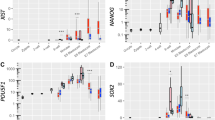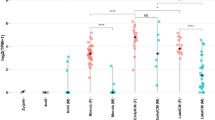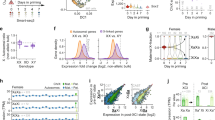Abstract
The long noncoding RNA Xist is expressed from only the paternal X chromosome in mouse preimplantation female embryos and mediates transcriptional silencing of that chromosome. In females, absence of Xist leads to postimplantation lethality. Here, through single-cell RNA sequencing of early preimplantation mouse embryos, we found that the initiation of imprinted X-chromosome inactivation absolutely requires Xist. Lack of paternal Xist leads to genome-wide transcriptional misregulation in the early blastocyst and to failure to activate the extraembryonic pathway that is essential for postimplantation development. We also demonstrate that the expression dynamics of X-linked genes depends on the strain and parent of origin as well as on the location along the X chromosome, particularly at the first 'entry' sites of Xist. This study demonstrates that dosage-compensation failure has an effect as early as the blastocyst stage and reveals genetic and epigenetic contributions to orchestrating transcriptional silencing of the X chromosome during early embryogenesis.
This is a preview of subscription content, access via your institution
Access options
Access Nature and 54 other Nature Portfolio journals
Get Nature+, our best-value online-access subscription
$29.99 / 30 days
cancel any time
Subscribe to this journal
Receive 12 print issues and online access
$189.00 per year
only $15.75 per issue
Buy this article
- Purchase on Springer Link
- Instant access to full article PDF
Prices may be subject to local taxes which are calculated during checkout





Similar content being viewed by others
Accession codes
References
Lyon, M.F. Gene action in the X-chromosome of the mouse (Mus musculus L.). Nature 190, 372–373 (1961).
Okamoto, I. et al. Evidence for de novo imprinted X-chromosome inactivation independent of meiotic inactivation in mice. Nature 438, 369–373 (2005).
Okamoto, I., Otte, A.P., Allis, C.D., Reinberg, D. & Heard, E. Epigenetic dynamics of imprinted X inactivation during early mouse development. Science 303, 644–649 (2004).
Mak, W. et al. Reactivation of the paternal X chromosome in early mouse embryos. Science 303, 666–669 (2004).
Galupa, R. & Heard, E. X-chromosome inactivation: new insights into cis and trans regulation. Curr. Opin. Genet. Dev. 31, 57–66 (2015).
Deng, Q., Ramskold, D., Reinius, B. & Sandberg, R. Single-cell RNA-seq reveals dynamic, random monoallelic gene expression in mammalian cells. Science 343, 193–196 (2014).
Kalantry, S., Purushothaman, S., Bowen, R.B., Starmer, J. & Magnuson, T. Evidence of Xist RNA-independent initiation of mouse imprinted X-chromosome inactivation. Nature 460, 647–651 (2009).
Namekawa, S.H., Payer, B., Huynh, K.D., Jaenisch, R. & Lee, J.T. Two-step imprinted X inactivation: repeat versus genic silencing in the mouse. Mol. Cell. Biol. 30, 3187–3205 (2010).
Chen, G. et al. Single-cell analyses of X chromosome inactivation dynamics and pluripotency during differentiation. Genome Res. 26, 1342–1354 (2016).
Tang, F. et al. RNA-Seq analysis to capture the transcriptome landscape of a single cell. Nat. Protoc. 5, 516–535 (2010).
Brockdorff, N. & Turner, B.M. Dosage compensation in mammals. Cold Spring Harb. Perspect. Biol. 7, a019406 (2015).
Nguyen, D.K. & Disteche, C.M. Dosage compensation of the active X chromosome in mammals. Nat. Genet. 38, 47–53 (2006).
Wang, F. et al. Regulation of X-linked gene expression during early mouse development by Rlim. eLife 5, e19127 (2016).
Patrat, C. et al. Dynamic changes in paternal X-chromosome activity during imprinted X-chromosome inactivation in mice. Proc. Natl. Acad. Sci. USA 106, 5198–5203 (2009).
Kobayashi, S. et al. The X-linked imprinted gene family Fthl17 shows predominantly female expression following the two-cell stage in mouse embryos. Nucleic Acids Res. 38, 3672–3681 (2010).
Calabrese, J.M. et al. Site-specific silencing of regulatory elements as a mechanism of X inactivation. Cell 151, 951–963 (2012).
Berletch, J.B. et al. Escape from X inactivation varies in mouse tissues. PLoS Genet. 11, e1005079 (2015).
Marks, H. et al. Dynamics of gene silencing during X inactivation using allele-specific RNA-seq. Genome Biol. 16, 149 (2015).
Balaton, B.P. & Brown, C.J. Escape artists of the X chromosome. Trends Genet. 32, 348–359 (2016).
Engreitz, J.M. et al. The Xist lncRNA exploits three-dimensional genome architecture to spread across the X chromosome. Science 341, 1237973 (2013).
Marahrens, Y., Panning, B., Dausman, J., Strauss, W. & Jaenisch, R. Xist-deficient mice are defective in dosage compensation but not spermatogenesis. Genes Dev. 11, 156–166 (1997).
Schulz, E.G. et al. The two active X chromosomes in female ESCs block exit from the pluripotent state by modulating the ESC signaling network. Cell Stem Cell 14, 203–216 (2014).
Nesbitt, A.M. Genomic imprinting of the X-linked gene transketolase-like 1 in mouse and human. ProQuest Diss. Theses A&I. 884624661 (2010).
Lee, J.T., Davidow, L.S. & Warshawsky, D. Tsix, a gene antisense to Xist at the X-inactivation centre. Nat. Genet. 21, 400–404 (1999).
Nishioka, N. et al. Tead4 is required for specification of trophectoderm in pre-implantation mouse embryos. Mech. Dev. 125, 270–283 (2008).
Niakan, K.K. et al. Sox17 promotes differentiation in mouse embryonic stem cells by directly regulating extraembryonic gene expression and indirectly antagonizing self-renewal. Genes Dev. 24, 312–326 (2010).
Graham, S.J.L. et al. BMP signalling regulates the pre-implantation development of extra-embryonic cell lineages in the mouse embryo. Nat. Commun. 5, 5667 (2014).
Rhee, C. et al. Arid3a is essential to execution of the first cell fate decision via direct embryonic and extraembryonic transcriptional regulation. Genes Dev. 28, 2219–2232 (2014).
Takahashi, Y. et al. SOCS3: an essential regulator of LIF receptor signaling in trophoblast giant cell differentiation. EMBO J. 22, 372–384 (2003).
Kobayashi, S. et al. Comparison of gene expression in male and female mouse blastocysts revealed imprinting of the X-linked gene, Rhox5/Pem, at preimplantation stages. Curr. Biol. 16, 166–172 (2006).
Li, Q., O'Malley, M.E., Bartlett, D.L. & Guo, Z.S. Homeobox gene Rhox5 is regulated by epigenetic mechanisms in cancer and stem cells and promotes cancer growth. Mol. Cancer 10, 63 (2011).
Petropoulos, S. et al. Single-cell RNA-seq reveals lineage and x chromosome dynamics in human preimplantation embryos. Cell 165, 1012–1026 (2016).
Fan, Y., Melhem, M.F. & Chaillet, J.R. Forced expression of the homeobox-containing gene Pem blocks differentiation of embryonic stem cells. Dev. Biol. 210, 481–496 (1999).
Cinelli, P. et al. Expression profiling in transgenic FVB/N embryonic stem cells overexpressing STAT3. BMC Dev. Biol. 8, 57 (2008).
Ancelin, K. et al. Maternal LSD1/KDM1A is an essential regulator of chromatin and transcription landscapes during zygotic genome activation. eLife 5, e0885 (2016).
McCloy, R.A. et al. Partial inhibition of Cdk1 in G 2 phase overrides the SAC and decouples mitotic events. Cell Cycle 13, 1400–1412 (2014).
Rozowsky, J. et al. AlleleSeq: analysis of allele-specific expression and binding in a network framework. Mol. Syst. Biol. 7, 522 (2011).
Gendrel, A.V. et al. Developmental dynamics and disease potential of random monoallelic gene expression. Dev. Cell 28, 366–380 (2014).
Kim, D. et al. TopHat2: accurate alignment of transcriptomes in the presence of insertions, deletions and gene fusions. Genome Biol. 14, R36 (2013).
Krueger, F. & Andrews, S.R. SNPsplit: allele-specific splitting of alignments between genomes with known SNP genotypes. F1000Res. 5, 1479 (2016).
Anders, S., Pyl, P.T. & Huber, W. HTSeq: a Python framework to work with high-throughput sequencing data. Bioinformat. ics 31, 166–169 (2015).
Robinson, M.D., McCarthy, D.J. & Smyth, G.K. edgeR: a Bioconductor package for differential expression analysis of digital gene expression data. Bioinformatics 26, 139–140 (2010).
Ritchie, M.E. et al. limma powers differential expression analyses for RNA-sequencing and microarray studies. Nucleic Acids Res. 43, e47 (2015).
Kharchenko, P.V., Xi, R. & Park, P.J. Evidence for dosage compensation between the X chromosome and autosomes in mammals. Nat. Genet. 43, 1167–1169, author reply 1171–1172 (2011).
Acknowledgements
We thank S. Bao and N. Grabole for experimental assistance in single-blastomere RNA sequencing and M. Guttman for sharing the coordinates of Xist entry sites. We are grateful to P. Gestraud and V. Sibut for help in statistical and IPA pathway analysis, respectively. We thank the pathogen-free barrier animal facility of the Institut Curie and J. Iranzo for help with the animals, and the Cell and Tissue Imaging Platform (PICT-IBiSA; member of France–Bioimaging) of the Genetics and Developmental Biology Department (UMR3215/U934) of the Institut Curie for assistance with light microscopy. We acknowledge E. Schulz, E. Nora, I. Okamoto and the members of E.H.'s laboratory for assistance, feedback and critical input. This work was funded by a fellowship from the Région Ile-de-France (DIM STEMPOLE) to M.B.; the Paris Alliance of Cancer Research Institutes (PACRI-ANR) to L.S.; an ERC Advanced Investigator award (ERC-2010-AdG, no. 250367), EU FP7 grants SYBOSS (EU 7th Framework G.A., no. 242129) and MODHEP (EU 7th Framework G.A., no. 259743), La Ligue, Fondation de France, Labex DEEP (ANR-11-LBX-0044), part of the IDEX Idex PSL (ANR-10-IDEX-0001-02 PSL), and ABS4NGS (ANR-11-BINF-0001) to E.H.; France Genomique National infrastructure (ANR-10-INBS-09) to E.H., N.S. and E.B; and CELLECTCHIP (ANR-14-CE10-0013) to E.H. and M.B.
Author information
Authors and Affiliations
Contributions
M.B., A.S. and E.H. conceived the study. M.B. performed most of the experiments. K.A. performed the immunofluorescence, and P.D., C.P., M.B. and R.G. performed the RNA-FISH experiments. T.L., J.-B.L. and C.-J.C. performed single-cell transcriptome library preparation and sequencing. L.S., M.B., C.-J.C., I.V., N.S. and E.B. defined the data-processing and bioinformatics analysis. L.S. built the computational pipeline for scRNA-seq and analyzed the data with M.B.; M.B. and E.H. wrote the paper.
Corresponding author
Ethics declarations
Competing interests
The authors declare no competing financial interests.
Integrated supplementary information
Supplementary Figure 1 Hierarchical clustering of scRNA-seq.
Hierarchical clustering of single cell transcriptomes, based on Spearman’s correlation. Cells were clustered by developmental stage, then by cross (BC or CB), and finally according to their sex. ScRNAseq samples called 64C are related to the early blastocyst stage. n=184 single cell samples
Supplementary Figure 2 Single-cell RNA-sequencing data corroborate RNA-FISH-based silencing kinetics.
Candidate X-linked gene silencing kinetics (scRNA-seq) is compared to previous kinetics studied by RNA-FISH in Patrat et al, 200914. Mean of maternal and paternal reads are respectively represented as red or blue lines. Percentage of parental origin transcript (top panel) and level of expression in RPRT (bottom panel) of each gene are represented between oocytes and blastocysts.
Supplementary Figure 3 Gene validation by RNA-FISH and chromosome-wide representation of parental expression ratio.
(a) Nascent RNA FISH using probes recognizing Xist (signal in green) and Atrx (signal in red) RNAs on a 16C female embryo. DAPI is in blue. Right pictures are enhanced pictures of two individual blastomeres. Percentage of nuclei showing pinpoints of nascent transcripts by RNA FISH from Xp and Xm has been assessed and summarized as the median + s.e.m. under the picture. Normalization of the primary transcript detection frequency obtained for the paternal (Xist RNA-associated) allele in female embryos was achieved thanks to the detection frequency obtained for the maternal allele in male embryos at the same stage. Number of embryos and single cell processed are indicated under each genotype. Scale bars represent 10μm.
(b) Heatmaps are shown representing the mean of allele-specific expression of X-linked genes, from Oocytes to blastocysts in CB and BC crosses. Strictly maternally expressed genes (allelic ratio ≤0.15) are represented in red and strictly paternally expressed genes (allelic ratio ≥0.85) in blue. Color gradients are used in between and genes have been ordered by genomic position. Oocytes and 2C stage data, as well as strain-specific gene expression data, have been included, in addition to the heatmaps for the stages shown in Figure 2.
Supplementary Figure 4 Complete single-cell information of X-linked gene expression in preimplantation development.
Heatmap representing the full allele-specific expression data set of informative and well-expressed X-linked genes in each single cell, from oocytes to blastocysts, in male and female embryos derived from BC and CB crosses. Strictly maternally expressed genes (allelic ratio ≤0.15) are represented in red and strictly paternally expressed genes (allelic ratio ≥0.85) in blue. Color gradients are used in between and genes have been ordered by genomic position. Genes expressed in one or both crosses have been included to the single cell heatmap. n=173 genes.
Supplementary Figure 5 Lack of X-chromosome inactivation in the absence of Xist.
(a) Each plot represents a candidate X-linked gene that was previously studied in Kalantry et al, 20096. Allele-specific expression ratio of each gene represents the number of reads mapped on paternal genome divided by the total number of paternal and maternal reads. Mean of maternal and paternal reads are respectively represented as a red or a blue line. Percentage of parental origin transcript (top panel) and level of expression in RPRT (bottom panel) of each gene are represented between 8-cell stage and blastocysts.
(b) A table summarizing the total differentially expressed (DE) genes between CB wt and CB Xistpat∆ female embryos during early development and their localization on X chromosomes or autosomes. The percentages shown correspond to the distribution of total DE genes between autosomes and X chromosomes. The blastocyst stage is highlighted in red and candidate DE genes from this stage have been analyzed in Figure 4. List of DE genes is available in Supplementary Data Set 2.
Supplementary information
Supplementary Text and Figures
Supplementary Figures 1–5 and Supplementary Tables 1 and 2 (PDF 1995 kb)
Supplementary Data Set 1
Summary of single cell RNA-seq samples. For each library isprovided: single cell's name, stage, embryo number, gender, crossand the raw read number, filtered ones and percentage of mapping. (XLS 68 kb)
Supplementary Data Set 2
Misregulated genes in absence of paternal Xist. Table summarizing all the genes significantly different between CB wtand CB XistpatΔ female embryos during early development (8-cell toblastocyst). (XLS 476 kb)
Supplementary Data Set 3
Pathways and candidate genes downregulated in XistpatΔ femaleblastocysts and highlighted by IPA analysis. Summary of all the pathway and candidate genes and relationships, which have emerged from IPA analysis between CB wt and CB XistpatΔ female blastocysts. (XLSX 52 kb)
Rights and permissions
About this article
Cite this article
Borensztein, M., Syx, L., Ancelin, K. et al. Xist-dependent imprinted X inactivation and the early developmental consequences of its failure. Nat Struct Mol Biol 24, 226–233 (2017). https://doi.org/10.1038/nsmb.3365
Received:
Accepted:
Published:
Issue Date:
DOI: https://doi.org/10.1038/nsmb.3365
This article is cited by
-
YY1 binding is a gene-intrinsic barrier to Xist-mediated gene silencing
EMBO Reports (2024)
-
Transcription regulation by long non-coding RNAs: mechanisms and disease relevance
Nature Reviews Molecular Cell Biology (2024)
-
Comparative developmental genomics of sex-biased gene expression in early embryogenesis across mammals
Biology of Sex Differences (2023)
-
Polycomb repressive complexes 1 and 2 are each essential for maintenance of X inactivation in extra-embryonic lineages
Nature Cell Biology (2023)
-
Maternal SMCHD1 controls both imprinted Xist expression and imprinted X chromosome inactivation
Epigenetics & Chromatin (2022)



